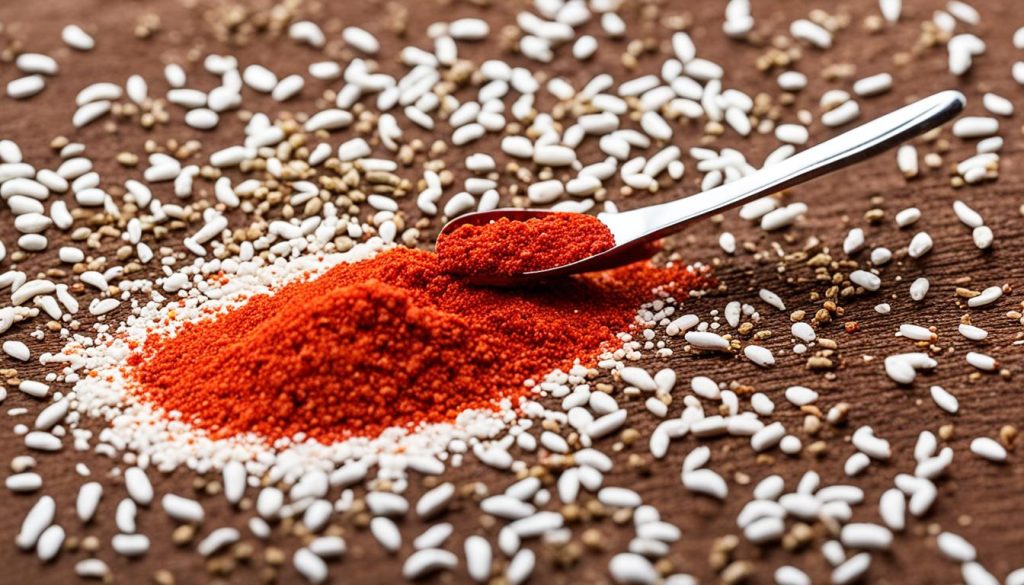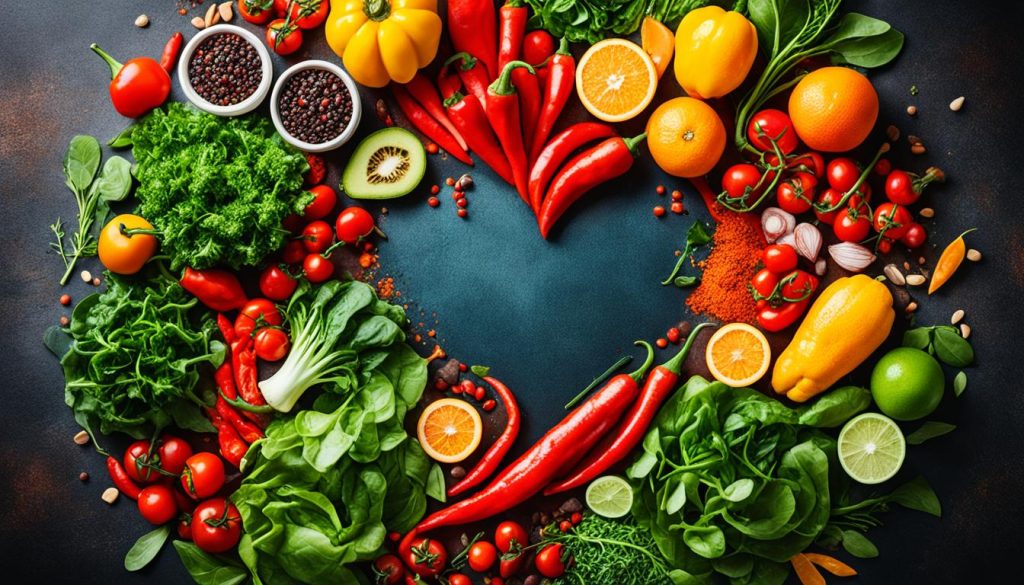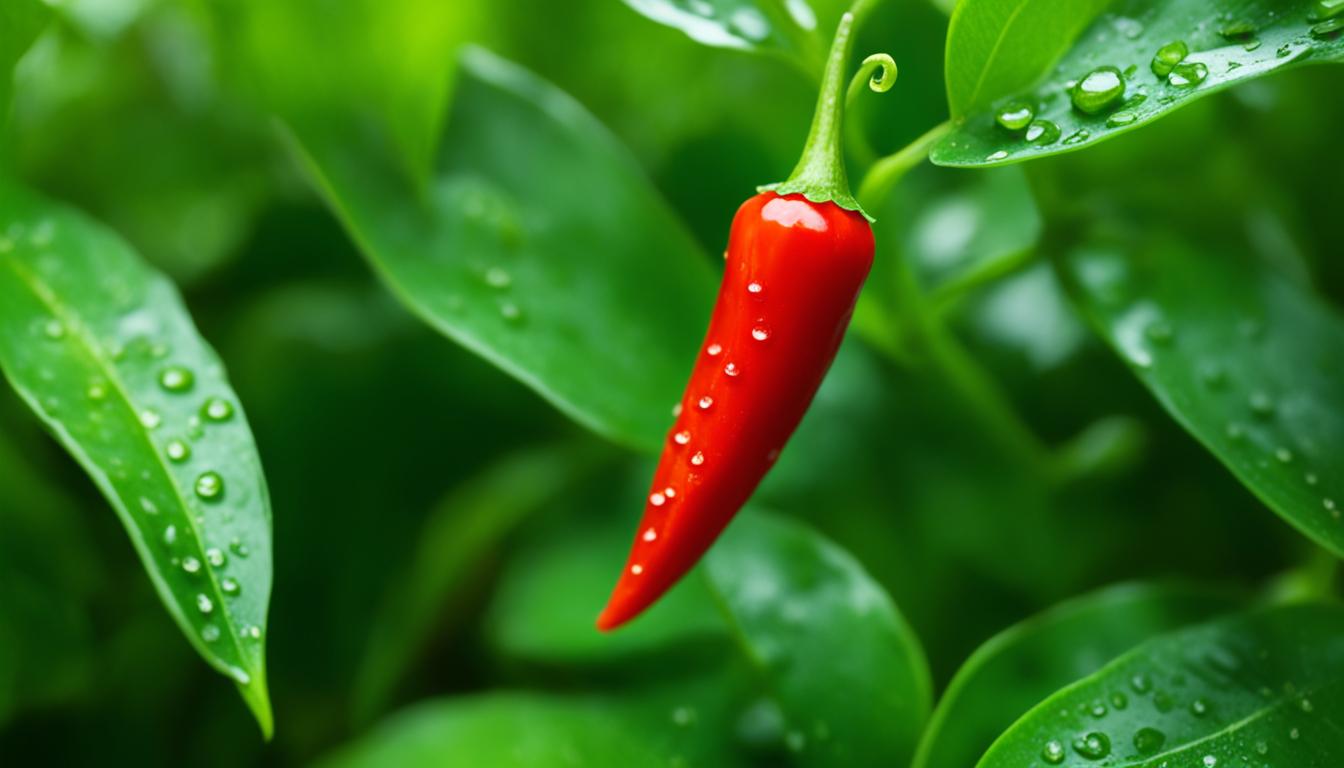Want to add some spice to your life or meals? Cayenne pepper could be the answer. It brings a unique flavor to your dishes and is packed with health perks. Adding cayenne peppers to your diet is a smart move for health.
Whether I use fresh peppers or dried cayenne, it’s a great choice. This spice is a must-have in every kitchen. It’s easy to see why it’s so popular.
Cayenne pepper has many benefits, like boosting metabolism and fighting inflammation. Adding it to my meals is a tasty way to stay healthy. It makes my morning eggs or chili extra special.
So, cayenne pepper is a key ingredient in any kitchen. It’s easy to use and adds a lot of flavor. Try it out and see the difference it makes.
What is Cayenne Pepper?
Cayenne peppers are a type of chili pepper known for their intense heat. They are long and thin, with a bright red color and a fiery taste. But they are more than just a spicy spice. Let’s explore their interesting origins and how they fit on the Scoville scale.
Origin and Classification of Cayenne Pepper
Cayenne peppers are officially called Capsicum annuum. They belong to the Solanaceae family, which also includes potatoes, eggplants, and tomatoes. Originating in South America, they have spread worldwide, adding heat and flavor to many dishes.
Heat Level of Cayenne Pepper on the Scoville Scale
| Pepper Variety | Scoville Heat Units (SHU) |
|---|---|
| Jalapeño Pepper | 2,500 – 8,000 SHU |
| Cayenne Pepper | 30,000 – 50,000 SHU |
| Habanero Pepper | 100,000 – 350,000 SHU |
Cayenne peppers have a heat level of 30,000 to 50,000 SHU on the Scoville scale. This makes them hotter than jalapeños but less hot than habaneros. The Scoville scale measures how spicy foods are.
Nutritional Value of Cayenne Pepper
Cayenne peppers add flavor to your meals and are full of nutrients. They have vitamins and minerals that are good for your health.
Vitamins and Minerals in Cayenne Pepper
Cayenne peppers are loaded with vitamin C. Just one pepper gives you 72% of what you need daily. They also have a lot of vitamin A, giving you 50% of your daily need in one pepper. Plus, they have vitamin B6 and vitamin K.
These peppers are rich in manganese, a key mineral for metabolism and bone health. A teaspoon of dried cayenne powder gives you 15% of your daily manganese.

The powdered form of cayenne pepper is still nutritious, even if not as much as fresh peppers. A teaspoon of dried cayenne powder gives you 15% of your daily vitamin A. It’s an easy way to get this important nutrient.
“Cayenne peppers are a nutritional powerhouse, packed with essential vitamins and minerals that can support your overall health and well-being.”
Health Benefits of Cayenne Pepper
Cayenne peppers are known for their bright red color and spicy taste. But they offer much more than just heat. They are full of vitamins, minerals, and antioxidants. These can help you stay healthy.
Boosting Cardiovascular Health
Cayenne pepper has a compound called capsaicin. This helps lower blood pressure and improve blood flow. It also cuts the risk of heart disease.
Aiding Digestion and Metabolism
Capsaicin in cayenne pepper helps make digestive juices flow better. This makes it easier to digest food and get nutrients. It can also help you burn calories faster, which is good for weight control.
Relieving Pain and Congestion
Cayenne pepper can ease pain and stuffy noses because it fights inflammation. Applying it to sore muscles can help. Eating it can clear your sinuses and ease headaches and migraines.
| Health Benefit | Key Mechanisms |
|---|---|
| Cardiovascular Health | Lowers blood pressure, improves circulation, reduces inflammation |
| Digestion and Metabolism | Stimulates digestive juices, boosts metabolic rate |
| Pain and Congestion Relief | Anti-inflammatory properties, sinus decongestant |
Adding cayenne pepper to your daily meals can be tasty and good for you. It helps with heart health, digestion, and more. This spice is worth trying for its many benefits.
Cayenne Pepper for Heart Health
Make your heart health better with cayenne pepper! This red chili is full of power for your heart. It has a compound called capsaicin that fights inflammation.
Anti-Inflammatory Properties of Cayenne Pepper
Inflammation can lead to heart disease. Cayenne pepper’s capsaicin lowers inflammation. This keeps blood vessels healthy and controls blood pressure. Eating chili peppers often can lower the risk of heart disease by 13%.
Cayenne pepper is good for your heart in many ways. Capsaicin improves blood flow and lowers cholesterol. It also stops plaque from building in arteries. Adding this spice to your meals can help keep your heart healthy.
| Benefit | Mechanism |
|---|---|
| Reduced Inflammation | Capsaicin’s anti-inflammatory properties help calm inflammation in the body. |
| Improved Blood Flow | Capsaicin can help dilate blood vessels, improving circulation and blood flow. |
| Lower Cholesterol | Cayenne pepper may help reduce LDL (bad) cholesterol levels. |
| Plaque Prevention | Capsaicin can inhibit the buildup of plaque in the arteries. |

Use cayenne pepper to make your heart healthier. Spice up your life for better heart health.
Improving Digestion with Cayenne Pepper
Spicy foods like cayenne pepper can help your digestion. It gets its heat from capsaicin, which boosts stomach juices and enzymes. This makes food break down better, helping your digestion.
Cayenne pepper also helps your gut microbiome. It changes the balance of bacteria in your intestines. This leads to better gut health and function.
But, spicy foods can cause heartburn or discomfort. Always listen to how your body reacts to cayenne pepper. It’s important to eat it in moderation.
| Benefits of Cayenne Pepper for Digestion | Potential Drawbacks |
|---|---|
|
|
Adding cayenne pepper to your meals can improve digestion and gut health. But, always watch how your body reacts. Experiment to find the right amount for you.
“Cayenne pepper is a powerful tool for improving digestion, but it’s important to listen to your body and find the right amount that works for you.”
Weight Loss and Cayenne Pepper
Adding cayenne pepper to your meals could help you lose weight. This spice not only makes food taste great but also helps your metabolism and weight loss.
How Cayenne Pepper Boosts Metabolism
Cayenne pepper has a compound called capsaicin that makes it hot. This compound increases your body’s heat production. Your body needs more energy to stay at a normal temperature, so you burn more calories.
Also, capsaicin can make you feel full. This can help you eat less and control your calorie intake. It’s great for avoiding overeating.
- Cayenne pepper’s capsaicin temporarily boosts thermogenesis, increasing calorie burn
- Capsaicin may help suppress appetite by triggering the release of hormones that make you feel fuller
- While the effect is modest, incorporating cayenne pepper into a balanced diet and active lifestyle can contribute to weight loss efforts

The weight loss benefits of cayenne pepper are not huge. But, it can be a good addition to a healthy diet and active life. It can help your metabolism and control your appetite, supporting your weight loss goals.
Pain Relief and Decongestion with Cayenne Pepper
Are you tired of a stuffy nose or a headache? Cayenne pepper might be the answer. This spice is not just for adding heat to food. It also helps with pain and clears congestion.
Cayenne pepper has capsaicin, which helps with pain. When you use it on your skin or eat it, it changes how your body feels pain. This makes it great for things like arthritis, muscle pain, and headaches.
Cayenne pepper is also good for clearing your nose when it’s stuffy. Its heat can make your nose membranes work better. This means you can breathe easier and feel better.
Cayenne Pepper for Pain Relief
- Using cayenne pepper cream on your skin can ease joint and muscle pain, like arthritis.
- Eating cayenne pepper or taking it as a supplement can lessen headache and migraine pain.
- Capsaicin in cayenne pepper blocks pain receptors, acting like a natural painkiller.
Cayenne Pepper for Decongestion
- Cayenne pepper’s heat can make your nose membranes work better, helping to clear congestion.
- Adding cayenne pepper to your food or taking it as a supplement can help with a stuffy nose and sinus problems.
- Its decongestant effects are great for sinusitis and the common cold.
“Cayenne pepper is a natural powerhouse when it comes to pain relief and decongestion. Its spicy goodness can provide a soothing solution for a variety of ailments.”
Adding cayenne pepper to your diet or skin care can be easy and effective. It’s a great way to help with headaches, joint pain, or a blocked nose. This spice is a must-have for your health.
Creative Ways to Use Cayenne Pepper
Cayenne pepper makes many dishes taste better, both savory and sweet. You can use fresh peppers or the powdered kind. It adds a fiery kick to your food.
Savory and Sweet Dishes with Cayenne Pepper
Cayenne pepper goes well with many foods and tastes. Add a little to your coffee for a new taste, or to your favorite hot chocolate. It mixes well with chocolate’s richness.
For savory dishes, cayenne pepper is great in stir-fries, marinades, and rubs. Use it in homemade salsa or on roasted veggies for a kick. It’s also good in meat dishes, like grilled chicken or chili.
Try cayenne pepper in baked goods too. It adds a warm touch to cookies, cakes, and breads. This spice makes sweet foods taste even better.

“Cayenne pepper is the ultimate flavor chameleon, seamlessly blending with both savory and sweet ingredients.”
Cayenne pepper is great for adding zing to meals or making something new. It’s a versatile spice for your spice cabinet. Try it in your cooking and find new ways to spice up your life.
Cooking with Fresh vs Powdered Cayenne Pepper
I love exploring the world of spices, and cayenne pepper is a favorite. You can use fresh or powdered cayenne to spice up your dishes. Let’s look at the good and bad of each to help you pick the best for your cooking.
Fresh cayenne peppers are full of flavor and health benefits. They have a lot of capsaicin, which makes them hot. They also have more vitamins and minerals than dried peppers. Use them to add a kick to sauces, marinades, and even desserts.
Powdered cayenne pepper is easier to use at home. Even though drying them might reduce some nutrients, they still have a lot of health benefits. It’s great for seasoning meats, veggies, and even popcorn. You can also use it in sweet dishes.
| Fresh Cayenne Pepper | Powdered Cayenne Pepper |
|---|---|
| Highest concentration of capsaicin and vitamins | Slightly lower in vitamins but still a good source |
| Vibrant, fresh flavor | Consistent, concentrated heat |
| Best for sauces, marinades, and fresh dishes | Ideal for seasoning meats, vegetables, and more |
Whether you pick fresh or powdered cayenne, a little is enough. Start with a small amount and adjust as needed. Try both forms to find the right mix of flavor and spice for your dishes.
Incorporating Cayenne Pepper into Your Diet
Adding cayenne pepper to your meals is easy. This spice can make many dishes taste better. Just sprinkle it on chili, stir-fries, or salsa for a kick.
Cayenne pepper is good for those who want less salt. It adds heat and flavor without extra sodium. Start with a little and add more as you like.
Keep ground cayenne pepper in your kitchen for easy use. It stays fresh for 3-4 years. Use it in marinades, rubs, or recipes to make your food more exciting and nutritious.

